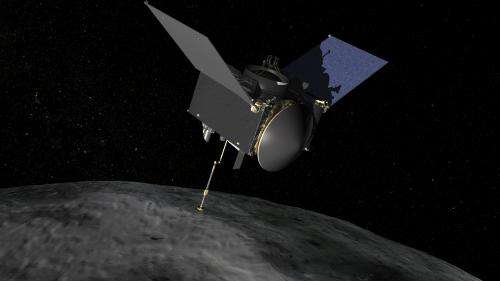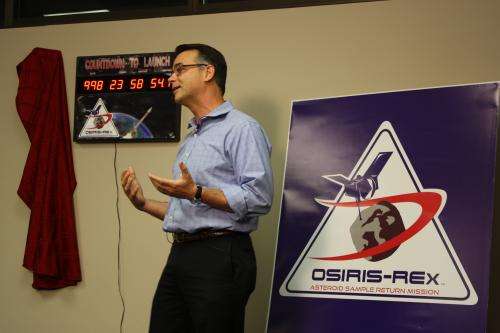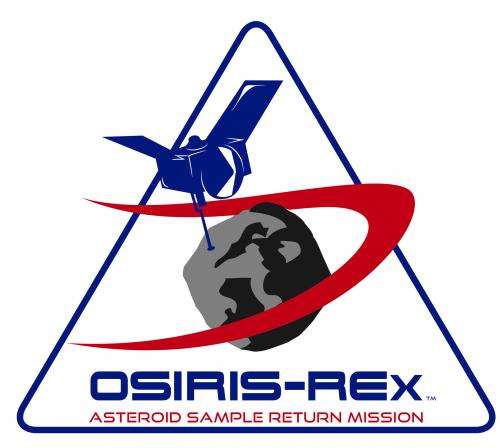Countdown starts for UA-led asteroid mission

(Phys.org) —With OSIRIS-REx, the first spacecraft destined to return a sample from a primitive asteroid, still taking shape, the mission's University of Arizona-led team started the official countdown clock on Monday at 5:43 p.m. MST. At that exact moment, 999 days remained until the opening of the mission's launch window on Sept. 3, 2016. The start of the clock also marks the launch of a new outreach and social media campaign to share the excitement about the mission, which comes with largest grant the UA has ever been awarded. The OSIRIS-REx mission is budgeted for more than $800 million, plus the launch rocket, which is supplied by NASA.
"This is a pioneering effort, both technologically and scientifically," said Dante Lauretta, the mission's principal investigator and a UA professor of planetary science. "Starting the countdown clock carries a lot of symbolism for us. We now have a constant reminder when we come to work in the morning of the time remaining to send OSIRIS-REx on its quest to return a sample of asteroid Bennu."
Mike Donnelly, OSIRIS-REx project manager at NASA's Goddard Spaceflight Center, said, "Nine hundred and ninety-nine days seems a long time to get the spacecraft on the pad, but we know that time will pass quickly. There is lots of work to do before our spacecraft begins its journey, and we have to be very disciplined to get everything done in time."
The world will be able to follow along on the team website. Daily updates about the mission – and interesting information about asteroid science – will be posted on Facebook; Twitter followers will get a special treat as the spacecraft itself will begin tweeting about its progress as it is comes together at the Lockheed Martin facility in Littleton, Colo.
OSIRIS-REx is scheduled to rendezvous with Bennu in 2018. Bennu is a primitive, carbonaceous asteroid that might pose a collision hazard to Earth at some point in the very distant future. OSIRIS-REx will swoop down onto the asteroid's surface, collect a sample and return it to Earth in 2023. The OSIRIS-REx mission promises to help scientists address some basic questions about the composition of the very early solar system, the source of organic materials and water that made life possible on Earth, and to better predict the orbits of asteroids that represent collision threats to the Earth.

"Osiris, the Egyptian god for which the project is named, was formed from pieces scattered across ancient Egypt, where he awoke as the bringer of life and ruler of the underworld," Lauretta said. "Our spacecraft has a similar story – it will consist of components fabricated in locations around the world that, once together, will allow us to connect with the outer reaches of our solar system."
In the next 999 days, the OSIRIS-REx team has to go through the last set of critical design reviews, Lauretta explained, to prove to NASA that all the hardware is space-flight-worthy.
"We are building the hardware in an engineering model form, which has the same form and function as the units that are going to fly on the spacecraft," he explained.
The spacecraft's three cameras are now under construction. They are: PolyCam, which will image the asteroid from afar and later from ultra close up; MapCam, used to scan and map the space rock; and SamCam, the sampling camera, which Lauretta said has just finished its first round of environmental qualification testing.
"We'll put those through what we call the shake-and-bake tests – we're going to shake them harder than the rocket is going to shake them, and bake them hotter than the sun is going to bake them, and put them through all the different environments they're going to experience in deep space and make sure they can still operate and achieve their functions out there. Every instrument, every subsystem on that spacecraft, has to go through that process."

With the starting of the countdown clock on Monday, the OSIRIS-REx website will kick off a new video feature called "321Science!," which will provide the public with an opportunity to learn more about scientific concepts important to our mission," said Lauretta.
321Science! focuses on asteroids and the OSIRIS-REx mission through a series of entertaining and engaging videos designed to explain concepts in planetary science and promote communication about and public engagement in the mission and solar system exploration. Regular installments are posted to the OSIRIS-REx YouTube page.
"Our goal is to make OSIRIS-REx a public mission," said Lauretta, who is blogging at dslauretta.com. "We want to share that journey, and that is why we are kicking off this new social campaign."
Provided by University of Arizona



















